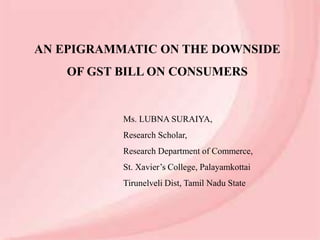
GST
- 1. AN EPIGRAMMATIC ON THE DOWNSIDE OF GST BILL ON CONSUMERS Ms. LUBNA SURAIYA, Research Scholar, Research Department of Commerce, St. Xavier’s College, Palayamkottai Tirunelveli Dist, Tamil Nadu State
- 3. INTRODUCTION India follows the federal tax system for levy and collection of various taxes. Different types of indirect taxes are levied and collected at different point in the supply chain. An announcement was made by P. Chidambaram, Union Finance Minister in the Central Budget (2007-2008) to the effect that GST would be introduced from April 1, 2010 and the Empowered Committee of State Finance Ministers, on his request, would work with the Central Government to prepare a road map for introduction of GST in India. An important interaction has also taken place between Pranab Mukherjee, Union Finance Minister and the Empowered Committee (October 19, 2009) discussed on phasing out CST. The Constitution Amendment Bill for Goods and Services Tax (GST) has been approved by The President of India in the Parliament (Rajya Sabha on 3 August 2016) and Lok Sabha on 8 August 2016) and ratification by more than 50% of state legislatures. The Government of India is committed to replace all the indirect taxes levied on goods and services by the Central and State govt.
- 4. MILESTONE OF GST January 2007: First GST study released by Dr. Shome May–October 2007: Empowered Committee was formed on GST Models. November 2007: Joint Working Group Report to FM. February 2008: FM announced introduction of GST in 2008-2009 Budget Speech. April 2008: EC finalized the views on GST. January 2009: Discussion of EC on CGST & SGST April 2010: GST was introduced
- 5. OBJECTIVES OF THE STUDY 1. To study about the concept of GST 2. To analyze the reasons that lead to GST. 3. To understand the negative consequences of GST. METHODOLOGY The study is based on Secondary Data. The data collection includes from: 1. National Information Utility (NIU) 2. Press Information Bureau, Government of India, Ministry of Finance. 3. Central Board of Excise and Customs. 4. Goods & Services Tax Network of Sec (8) under new companies Act, 28.03.2013 5. Alberta Treasury Board and Finance & Institute of Cost Accountants of India.
- 7. REASONS FOR GST 1. Economic Union of India and encourage the businessmen to focus on pan-India operations. 2. Simple tax structure being transparent in character allows to know exactly how much taxes are being charged and on what base to consumers. 3. Paperless work and reduction in accounting complexities. GST regime will boost the 'Make In India' programme as manufacturers will get input tax credits for capital goods. 4. Increasing the number of tax payers and generating the revenue for the government. 5. Exports of Indian goods in international markets by removing custom duties.
- 8. IMPACT OF GST IN INDIAN ECONOMY Reduces the tax burden Road blockage for perishable goods in toll plazas and check points Eradicate Buffer Stocks
- 10. SHORTCOMING OF GST UBS Securities study found that the truck drivers in India spend 60% of their time off roads negotiating check posts and toll plazas. 11 categories of taxes are levied on the road transport sector. The GST will help bring down logistical costs. According to the government estimates, excise tax exemptions result in revenues of Rs. 1.8 lakh crores. The comparable figure for the states is about Rs. 1.5 lakh crores. India loses about 2.7 per cent of GDP because of exemptions. Fear of inflation could rise in the short term under the GST tax regime, as tax rate may go up to 18 per cent from 15%.
- 11. GST would impact negatively on the real estate market. It would add up to 8 percent to the cost of new homes and reduce demand by about 12 percent. The credit of GST paid is claimed on the basis of invoice and the tie of the payment is immaterial. All declaration forms from industries point of view must be abolished like (Form F, C). With regard to classification of goods are yet to be decided. India's GST structure is complex says: IMF will improve tax compliances. Exports will become competitive as the GST regime will eliminate the cascading impact of taxes.
- 12. CONCLUSION In India, tax forming a major component of revenue, tax evasion is one of the major issues. Many steps are taken by government to reduce tax evasion. Value added tax has different effects on the society. Many efforts are taken to increase foreign direct investment to strengthen economy. Introduction of GST will help to reduce problems of tax system in India and lead to its improvement. The dark side of the GST should be considered if any lethargy is observed it can cause serious threat to the economy.